










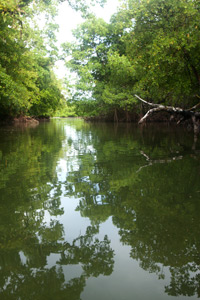
If Nan Madol is your primary destination, the southern route around Temwen is the shortest, following the tranquil passage of Dauen Moahk (a meditative way to begin or end the day). Note, however, that east-bound passage under the two bridges at Temwen Causeway is extremely difficult or impossible when the tide is coming in. The current flowing into the bay can be as powerful as a river.
Temwen Island Circumnavigation
For people that want an upper-body workout, the 8.9 km (5.3 mi) paddle around Temwen is an interesting journey with a variety of different sights along the way. Be informed on the tides before starting as the reefs on the northeast and northwest sides are only inches deep at low tide.
Heading north, there are wonderful views of scenic (but murky) Madolenihmw Bay and nearby Takaiuh and Nahnpahlap hills. Peipas Island, a man-made basalt burial structure that is probably related to Nan Madol, is hidden among the mangroves of Temwen’s western coast. 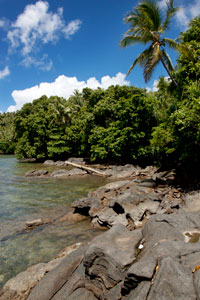 Further on, stony Salong Point juts north almost to the edge of the channel. Unusual eroded rock formations and a complete lack of mangroves make the place visually unique and worth a look. There’s also a small sea-cave and a portal in the topography that frames conical Takaiuh. Depending on tides and recent rain, the sheltered bay east of the point is sometimes a nice place for a dip, though there isn’t enough coral in the area for snorkeling.
Further on, stony Salong Point juts north almost to the edge of the channel. Unusual eroded rock formations and a complete lack of mangroves make the place visually unique and worth a look. There’s also a small sea-cave and a portal in the topography that frames conical Takaiuh. Depending on tides and recent rain, the sheltered bay east of the point is sometimes a nice place for a dip, though there isn’t enough coral in the area for snorkeling.
The segment between Salong Point and the Japanese Wharf can be a challenging paddle as Kepidauen Deleur is known for its rough water. This is apparently due to two seamounts in the area, called Mwudokendil and Mwudokensepehl. From the Japanese Wharf, it’s another 1.4 km (0.87 mi) to Nan Douwas. Enter the ruins from the north between Temwen and Peniot.
On the southern side of Temwen, you have the choice of several different channels through the mangroves, though all except Dauen Moahk are heavily silted in and impassable at low tide. The two largest islands between Temwen and Pohnpei — Mwudokalap and Mwudoketik — both host prehistoric stone structures related to Nan Madol. The former was the place where Isokelekel first encountered his estranged son, Nahlepenien, who would eventually become the first Nahnken and later the Nahnmwarki of U.
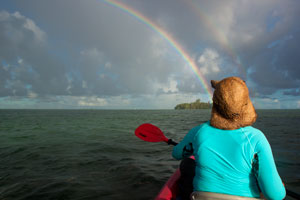
Nahnningi & Mall Islands
South of Temwen are Nahnningi (believed to be a man-made island from the Nan Madol era) and Mall islands. The latter has a stone tomb at the northern end. The Namwen Nahnningi Stingray Sanctuary lies northwest of the islands.
- Visit the Islands page for more information about these locations.
Other Islands
Five islands are found northeast of Temwen at the edge of the massive reef shelf called Mad Pahra. Nahpali is littered with Japanese-era historical sites and has a couple of nice sandy beaches. Little Dekehmwahu also has a nice, secluded beach, but to get to it, you’ll have to paddle around Nahpali’s southern side. Na island’s nicest coasts are on the north side. The same is true of Dekehtik. Nahkapw is a little apart from the others with easy access to the best snorkeling in the area.
- Visit the Islands page for more information about these locations.
Pahn Nahkapw & Kahnimweiso
The deep water between Nan Madol and Nahkapw at first appears to be a wide channel leading to the open ocean, but may in fact be something called a “blue hole.” It has been hypothesized that this trench is actually a collapsed portion of the reef shelf. Pohnpei oral histories speak of another stone city, called Kahnimweiso, that pre-dated Nan Madol and was said to lie where Pahn Nakapw is now. One theory proposes that the weight of the basalt constructions coupled with the undermining of the limestone reef shelf by freshwater run-off, could have caused a collapse and sent Kahnimweiso plummeting 65 meters to the bottom. When you see how the sandy shore at Nahkapw’s north end drops straight off into deep blue or experience the odd currents in the area, it’s not hard to believe that the site is special. To date, the theories have not been properly tested and Pahn Nahkapw has retained its secrets and its eerie feel.
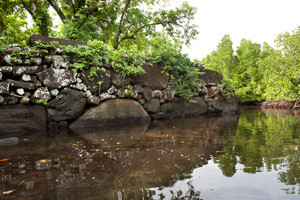
Nan Madol
If coming from the south, enter the ruins through Dauen Moahk, the first mangrove channel encountered (high tide only). The first stops include Pahn Kadira and Kelepwel islets. From there, you can venture northeast up the canal to Peikapw, Idehd, Dorong, and Peneiring. Further north, notable sites include Kerian, Peikapw Sapwawas, Dau, Pahn Douwas, Pohn Douwas, Nan Douwas, and Konderek. On the return trip south, catch Lemenkau and adjacent Namwenkau (pool) and the huge boulder wall of Pahnwi at the southwest corner. The upper portion of Mweiden Kitti is silted in and nearly closed off by encroaching mangrove trees; it’s impassable even at high tide. All of the entrances on Madol Pah‘s southwest perimeter are now dead-ends, but provide nice sandy spots to picnic.
From the north, it’s easiest to enter Nan Madol at Dauen Nankieilmwahu between Temwen and Peniot islet — especially when surge and choppy seas in Pahn Nahkapw make the narrow gap at Nan Mwoluhsei too risky.
Paddling Distances Around Temwen Island
| Starting |
|
Ending |
Distance (km) |
Distance (mi) |
| MERIP |
—- |
Temwen Causeway |
0.59 km |
0.37 mi |
| Temwen Causeway |
—- |
Pahn Kadira islet* |
1.7 km |
1.0 mi |
| Dauen Moahk |
—- |
Pahnwi islet |
0.89 km |
0.55 mi |
| Pahnwi islet |
—- |
Lemenkau islet* |
0.58 km |
0.36 mi |
| Lemenkau islet |
—- |
Dorong islet* |
0.62 km |
0.39 mi |
| Lemenkau islet |
—- |
Peinering islet* |
0.39 km |
0.25 mi |
| Peinering islet |
—- |
Kerian islet* |
0.42 km |
0.26 mi |
| Peinering islet |
—- |
Nan Douwas islet* |
0.41 km |
0.25 mi |
| MERIP |
—- |
Salong Point |
2.2 km |
1.37 mi |
| Salong Point |
—- |
Japanese Wharf |
1.0 km |
0.64 mi |
| Japanese Wharf |
—- |
Nan Douwas islet* |
1.4 km |
0.87 mi |
| Japanese Wharf |
—- |
Nahpali Island |
2.63 km |
1.63 mi |
| Nahpali Island |
—- |
Dekehmwahu Island |
2.00 km |
1.5 mi |
| Kerian islet |
—- |
Nahkapw Island |
0.89 km |
0.55 mi |
| Nahkapw Island |
—- |
Dekehtik Island |
0.52 km |
0.32 mi |
| Dekehtik Island |
—- |
Northern Na Island |
2.9 km |
1.8 mi |
| Northern Na Island |
—- |
Dekehmwahu Island |
0.77 km |
0.48 mi |
| Mweiden Kitti |
—- |
Nahnningi Island |
0.69 km |
0.43 mi |
| Nahnningi Island |
—- |
Mall Island |
0.42 km |
0.26 mi |
*Silted-in estuary. This segment may be difficult or impossible to traverse at low tide.
Map Guides >> Temwen Vicinity >> Temwen Vicinity Paddling


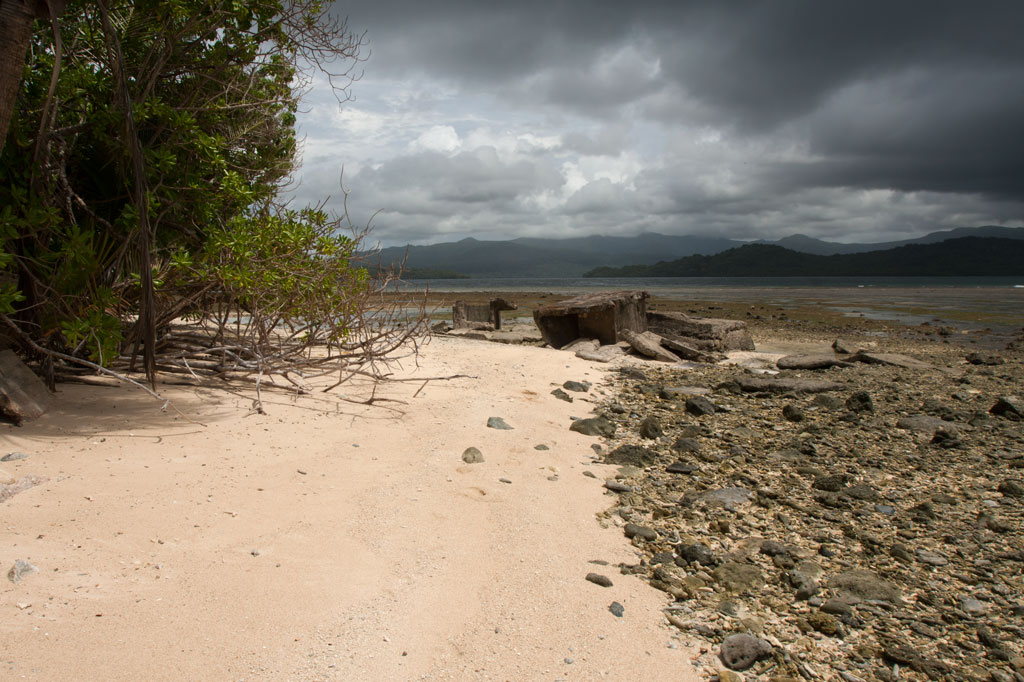
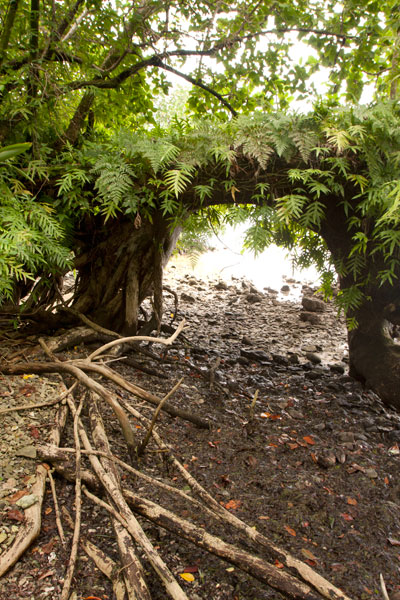
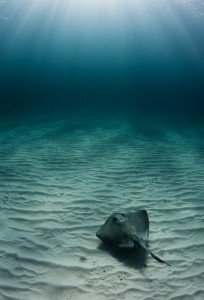
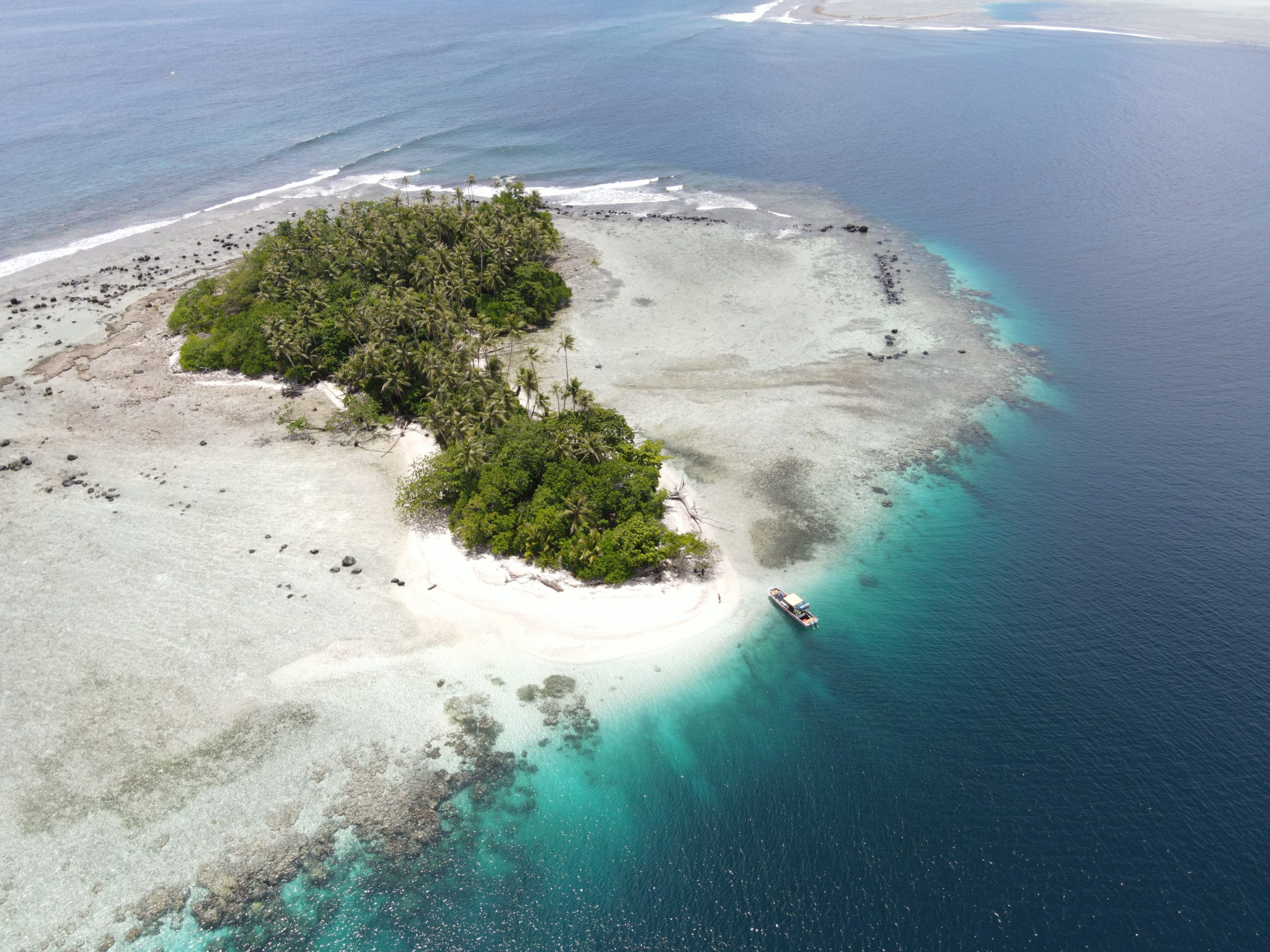
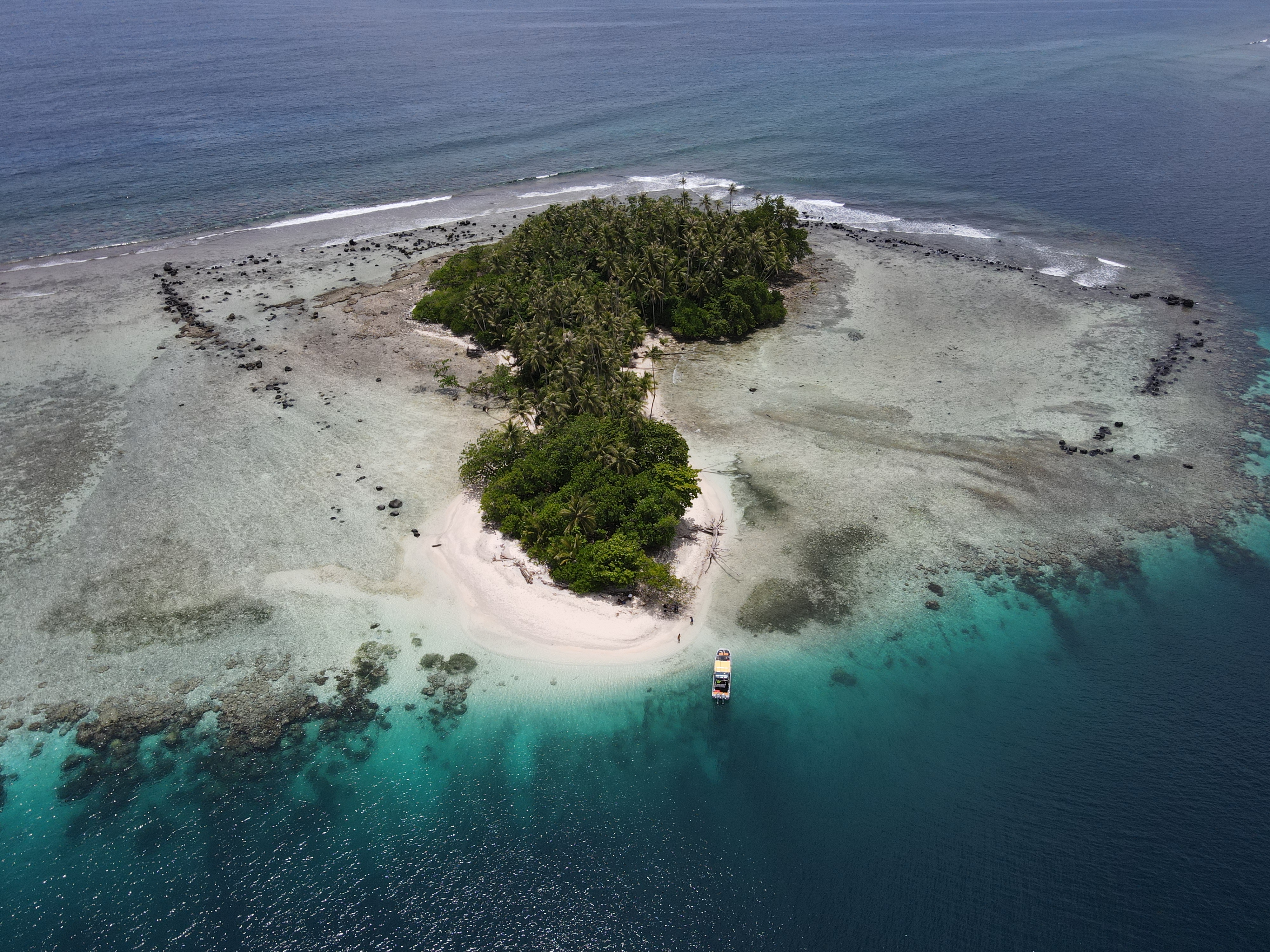
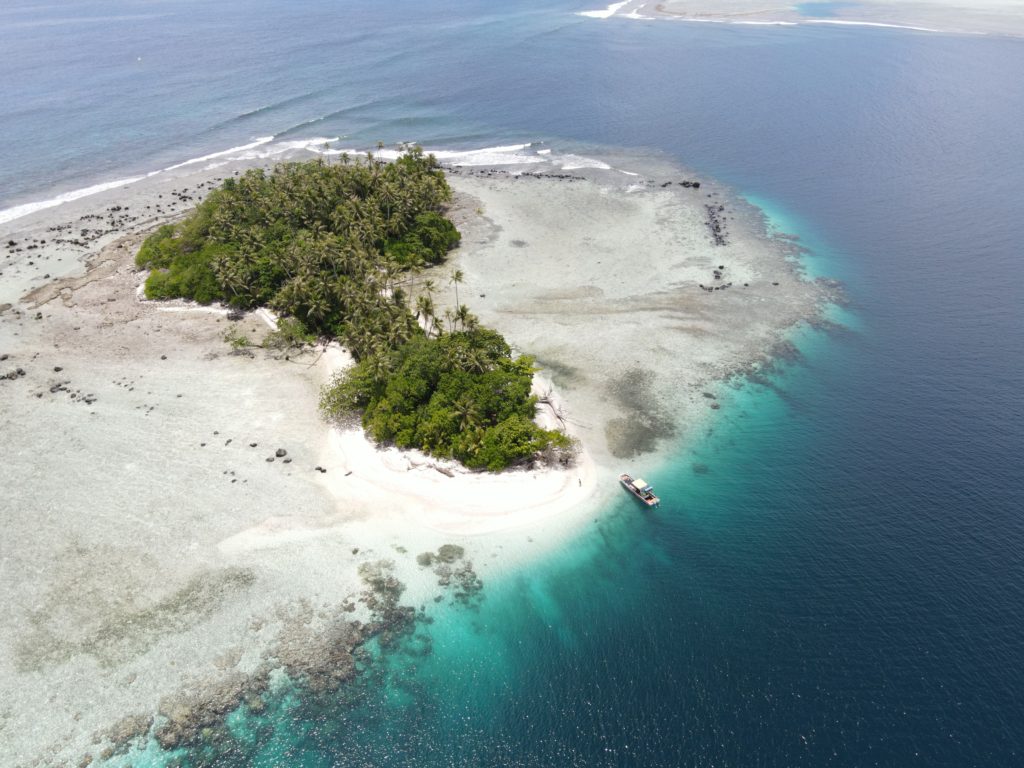
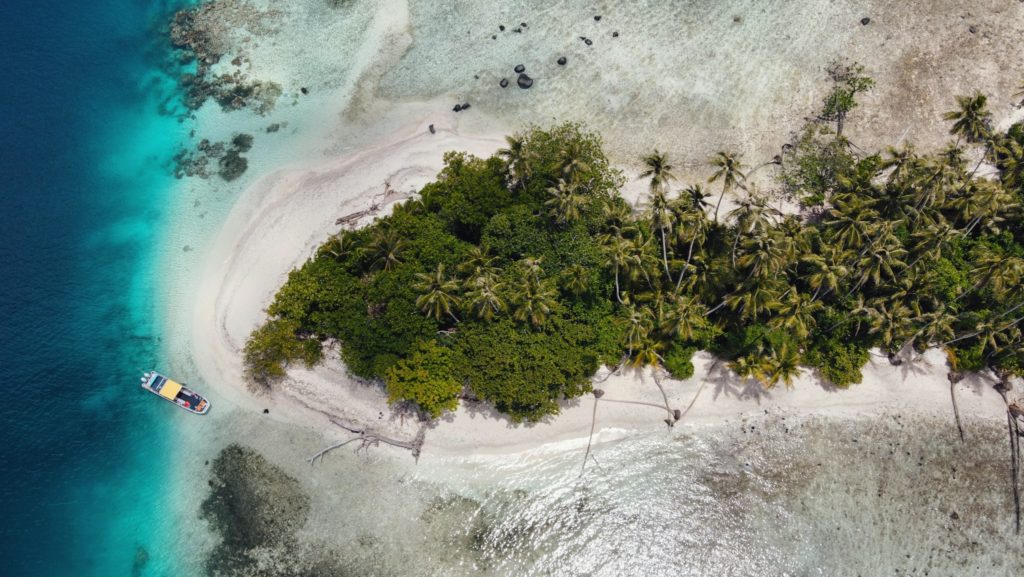
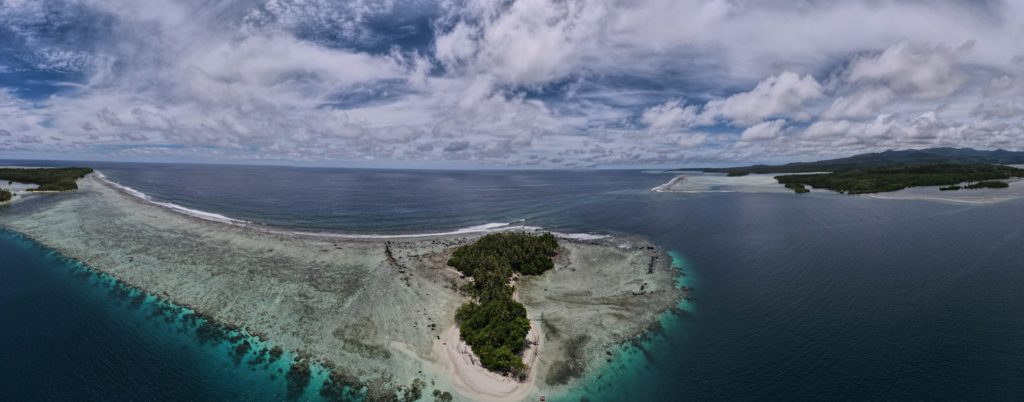
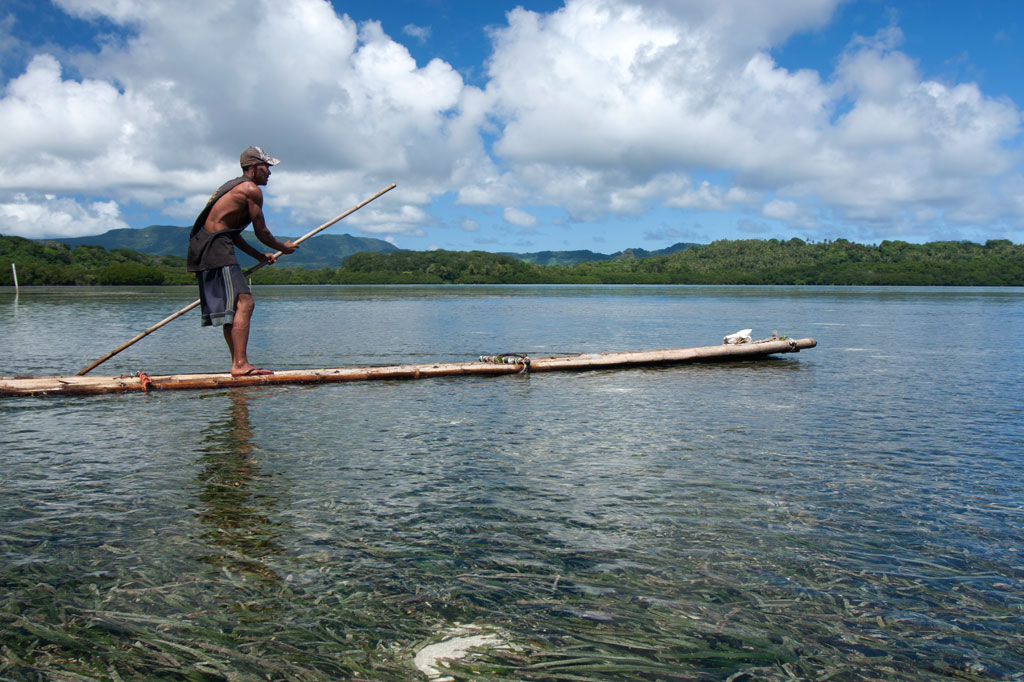
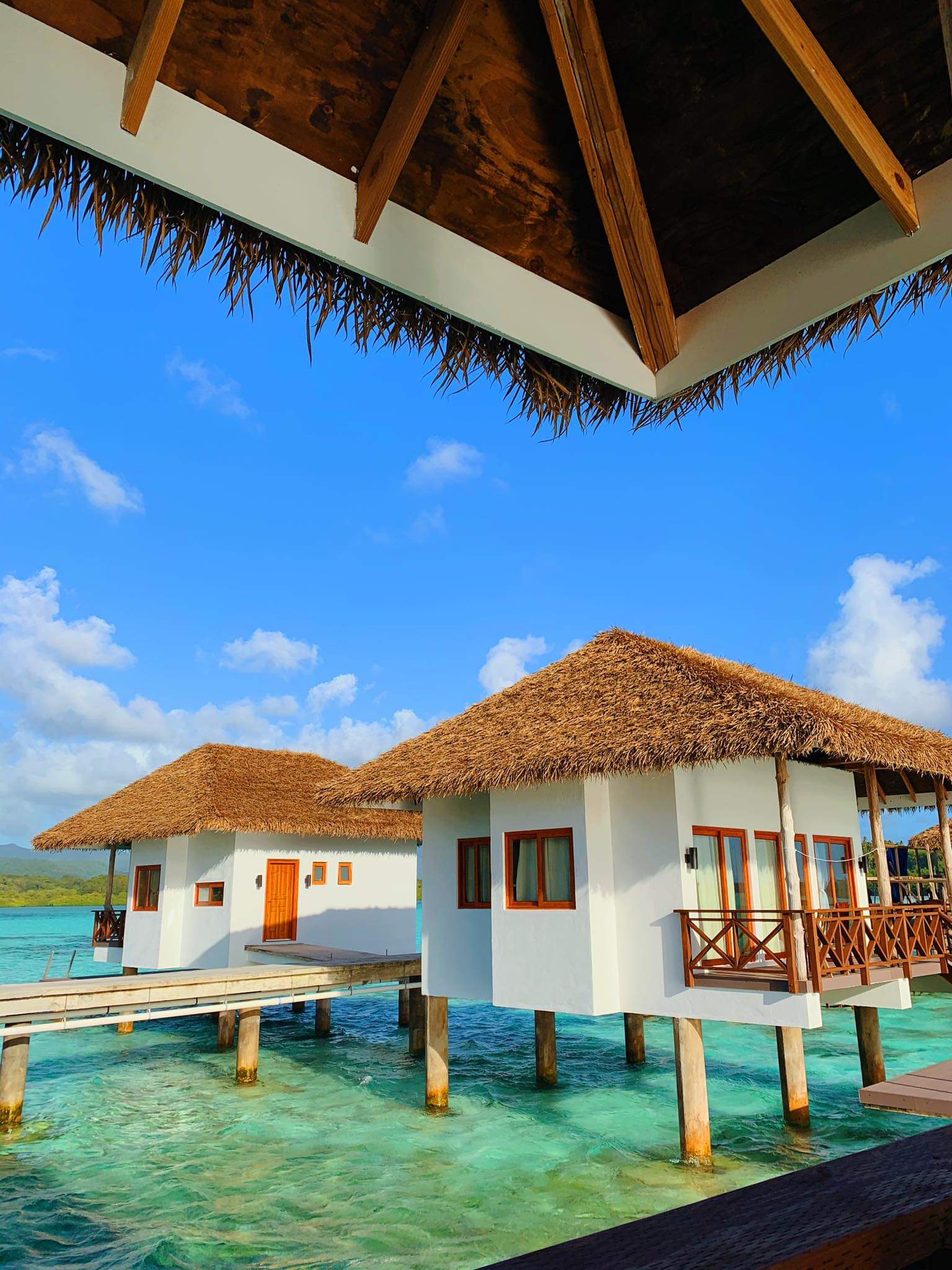
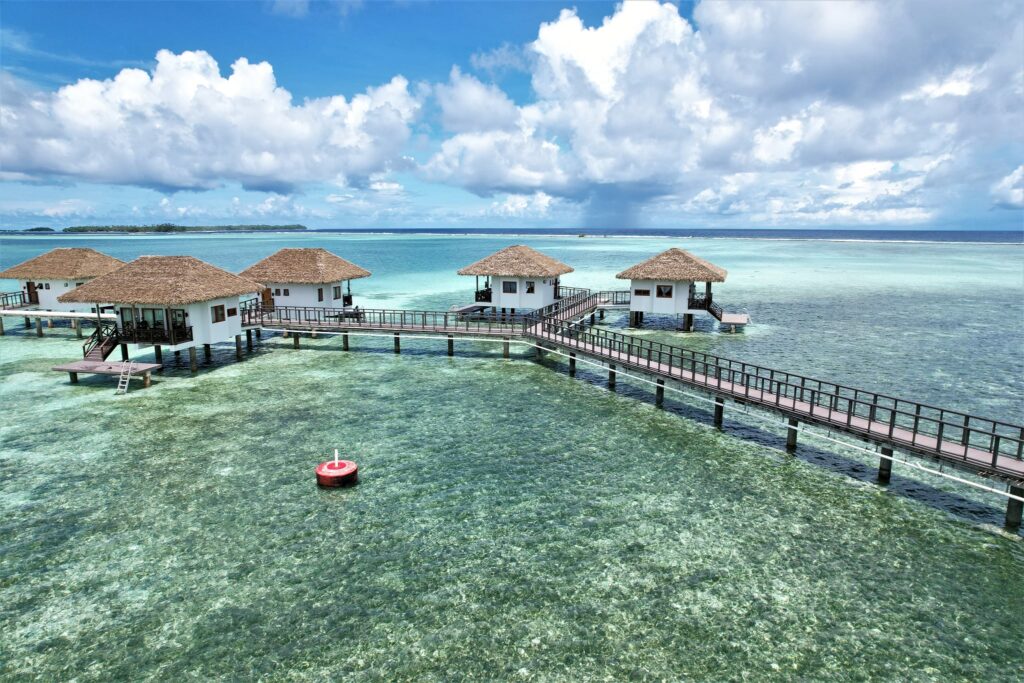
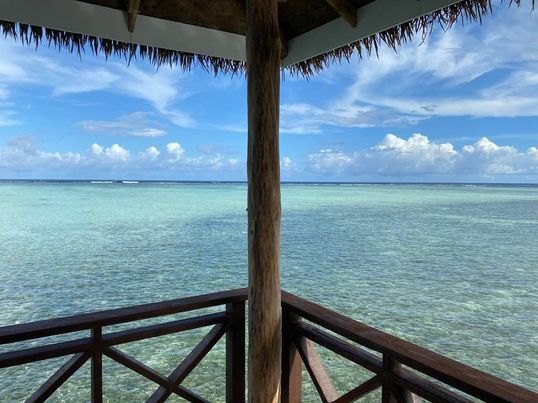
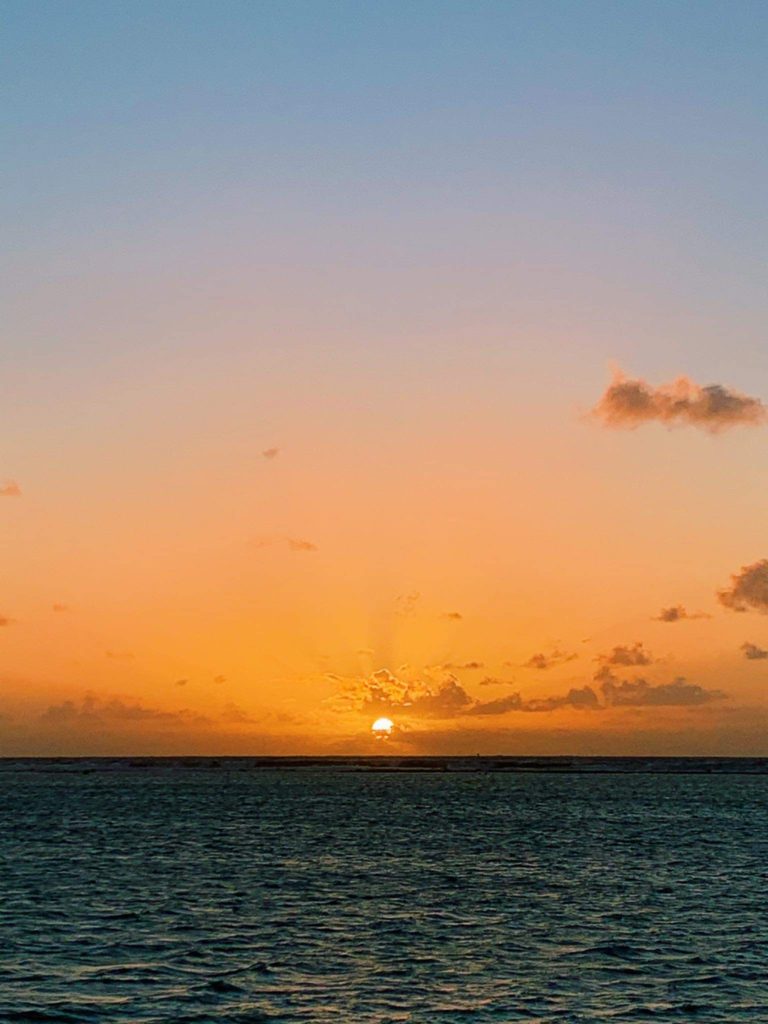
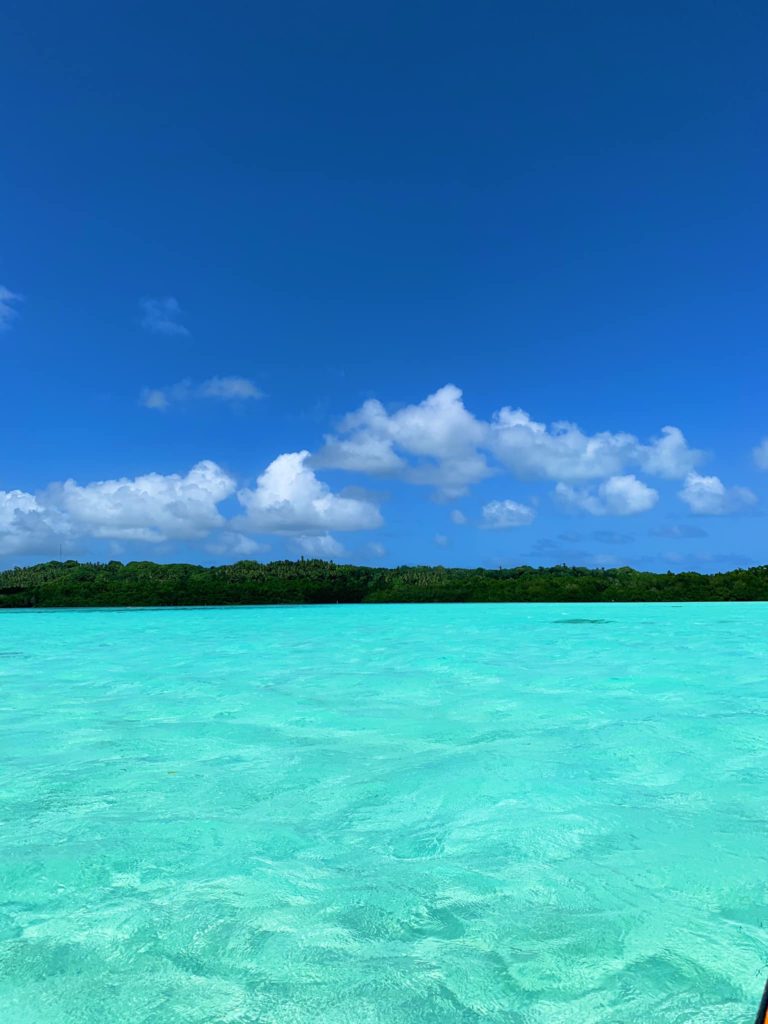
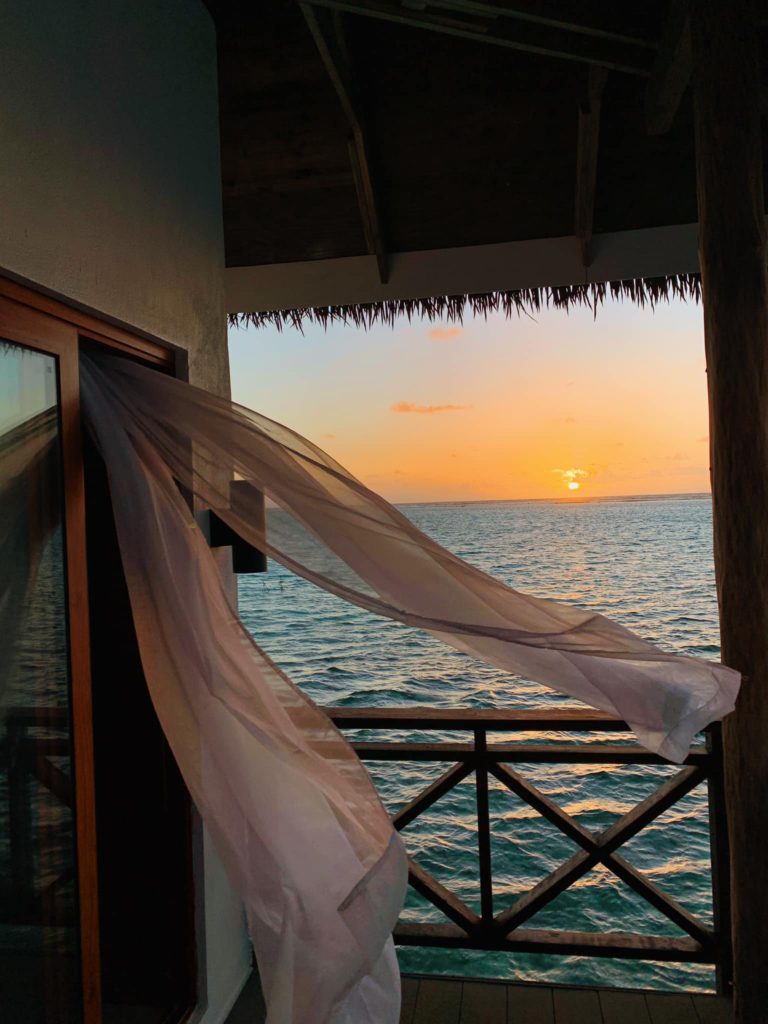
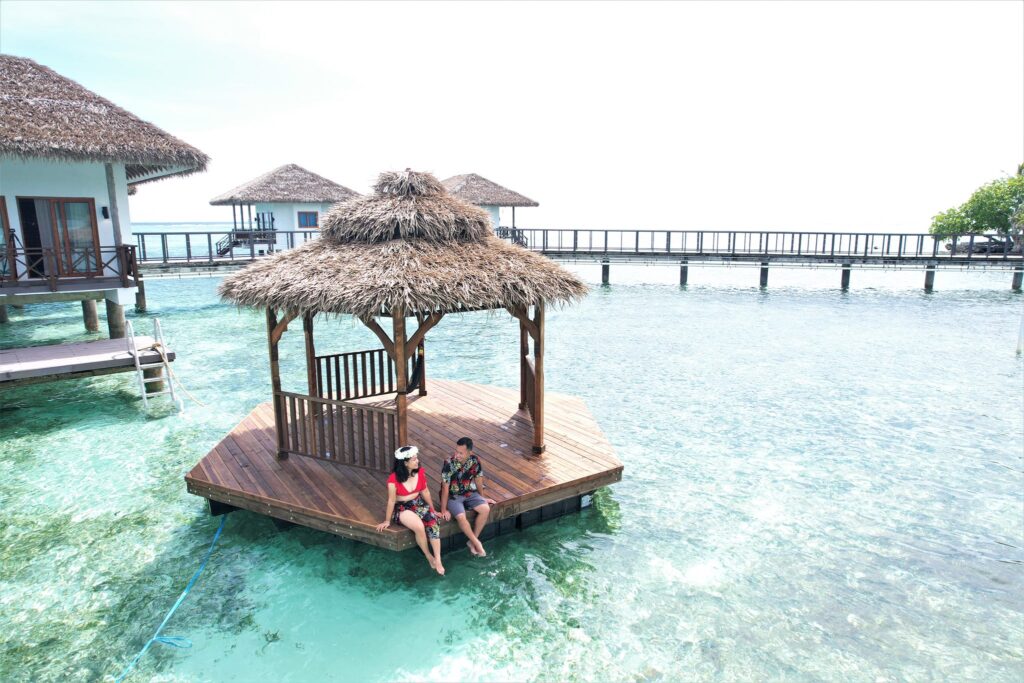
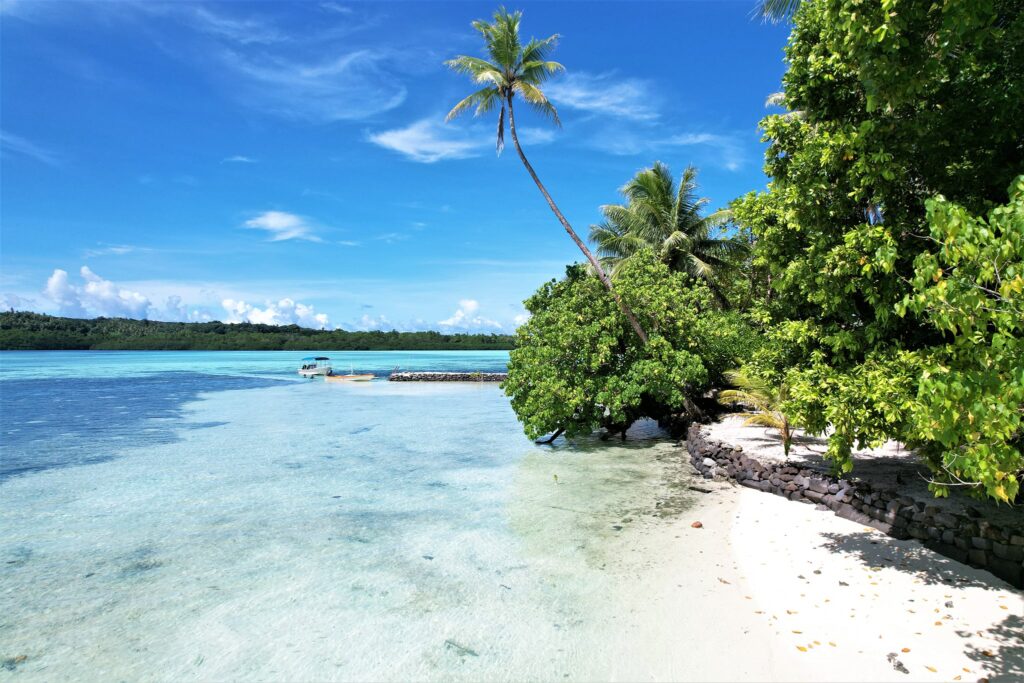
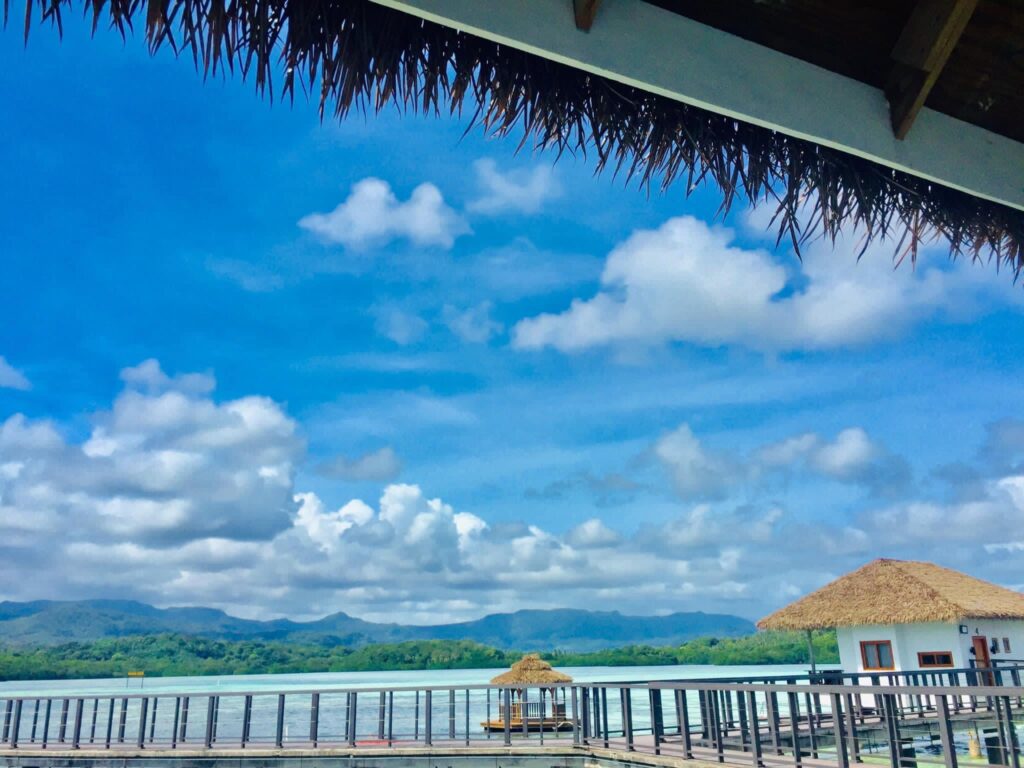
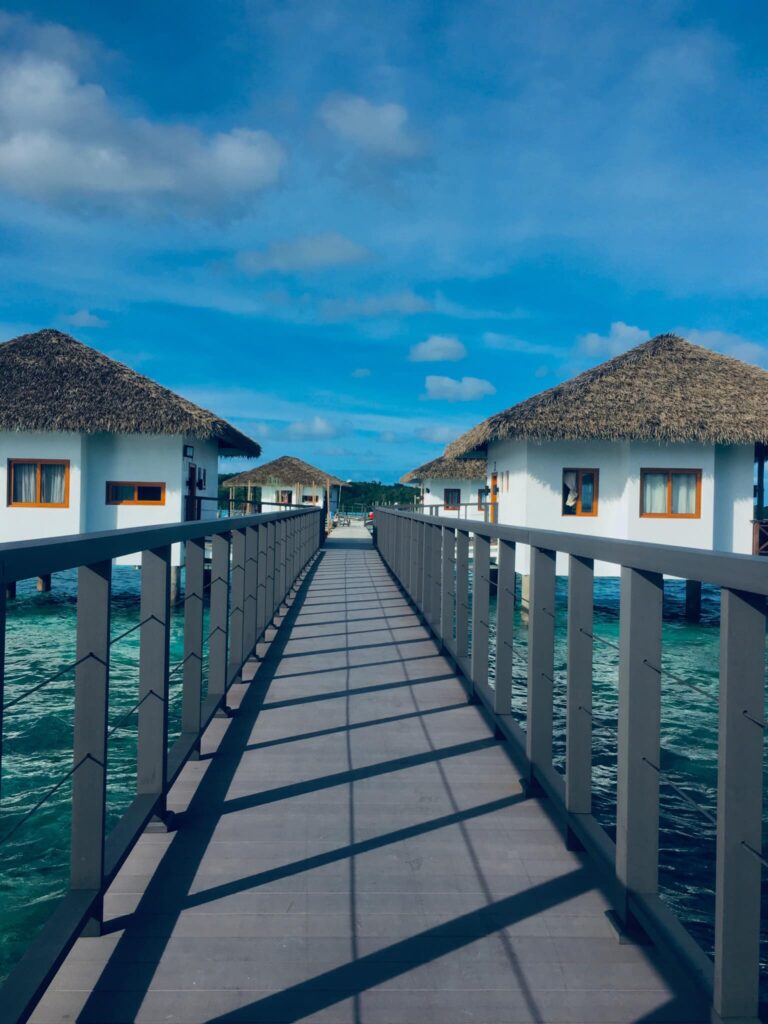
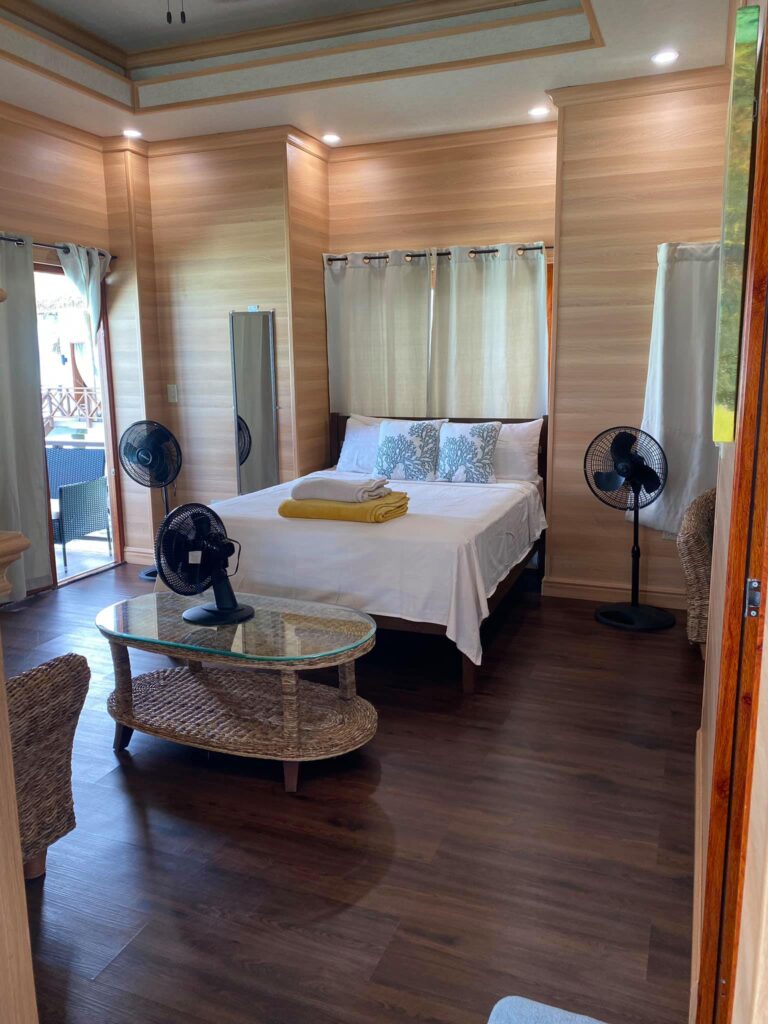
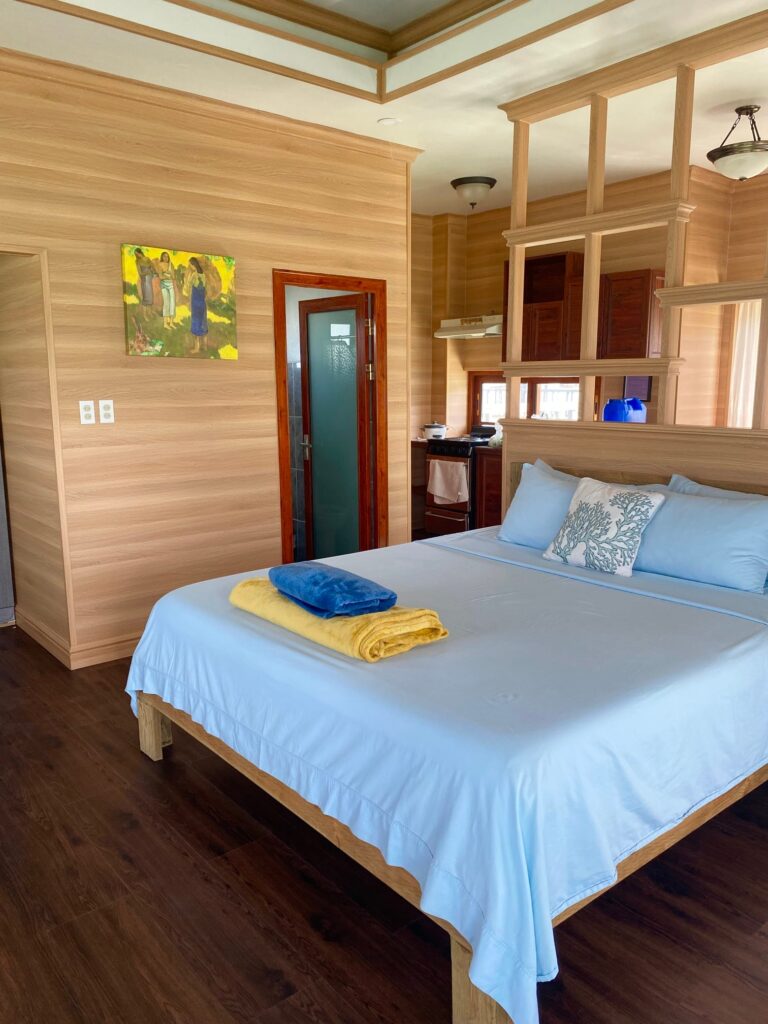
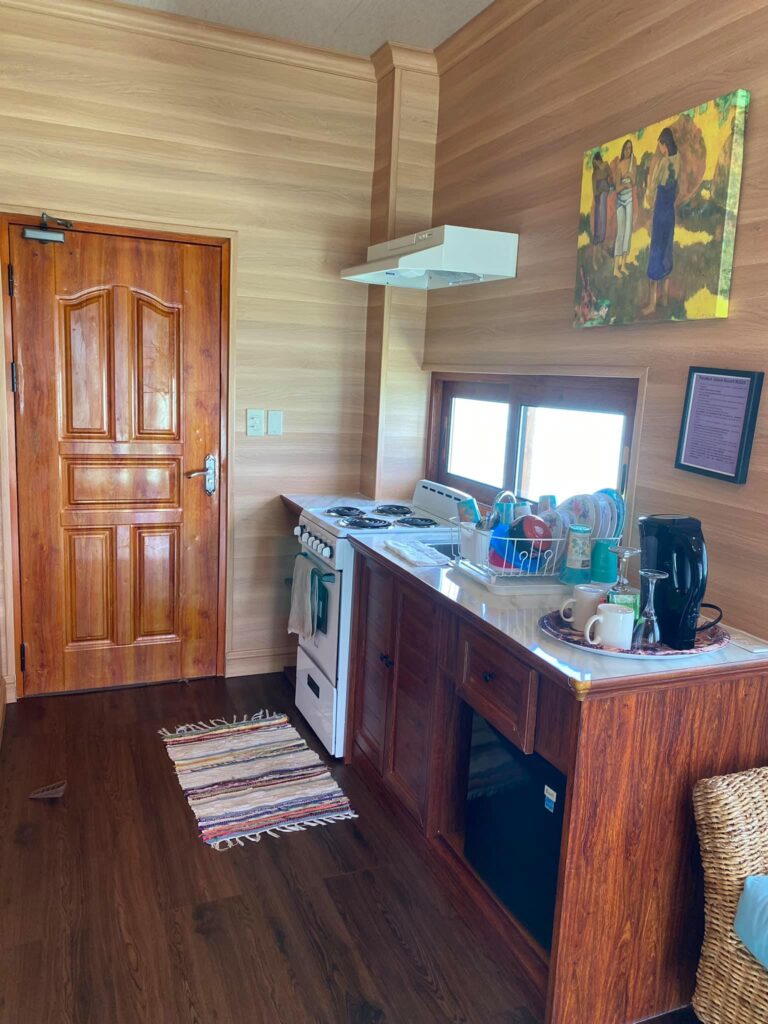
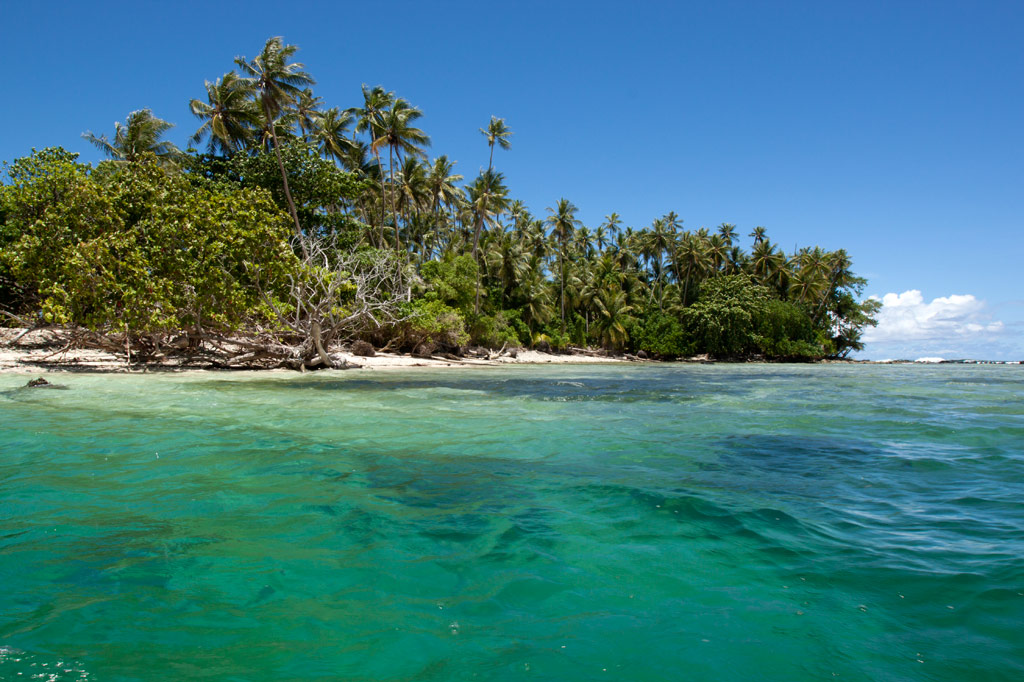
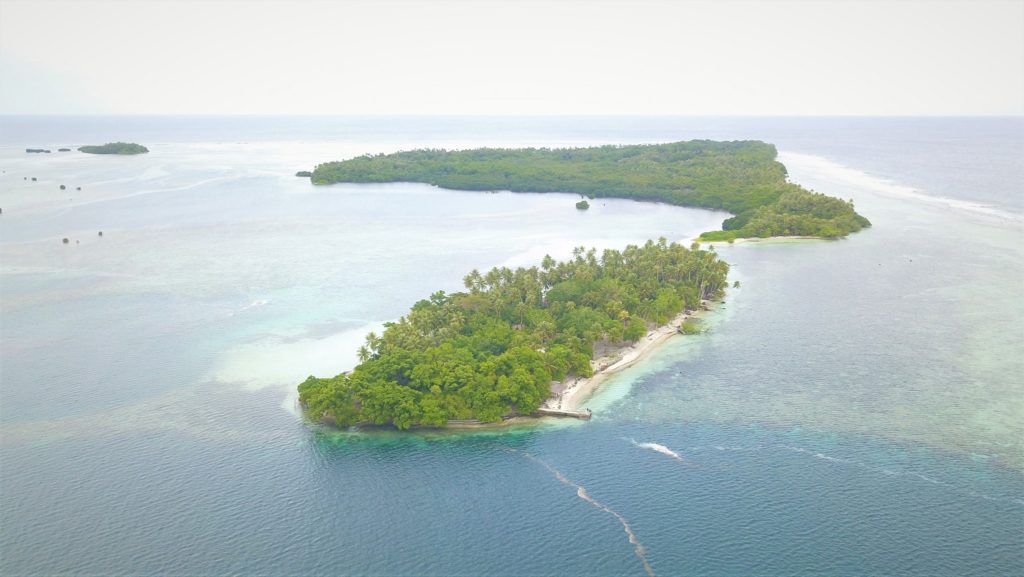
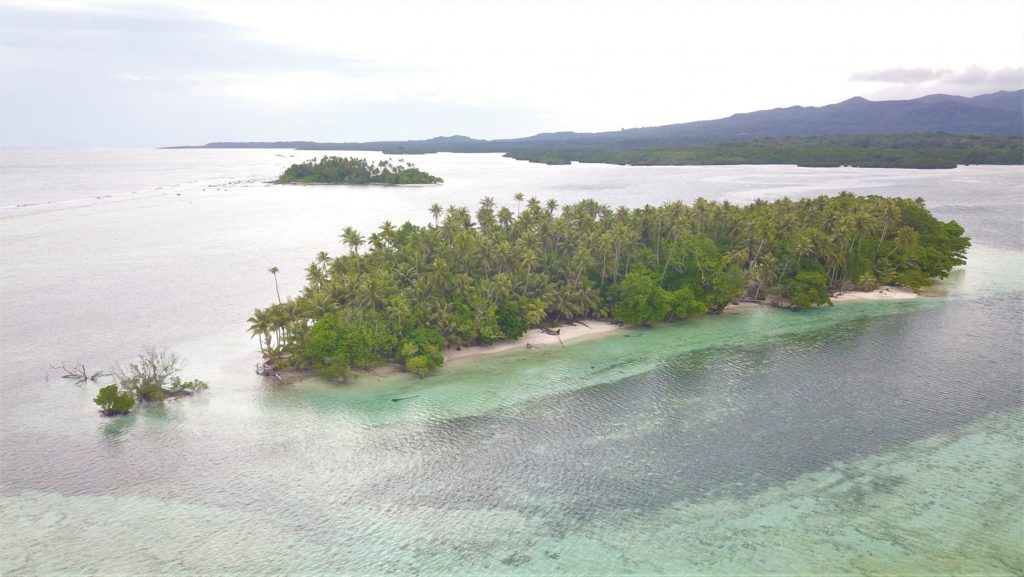
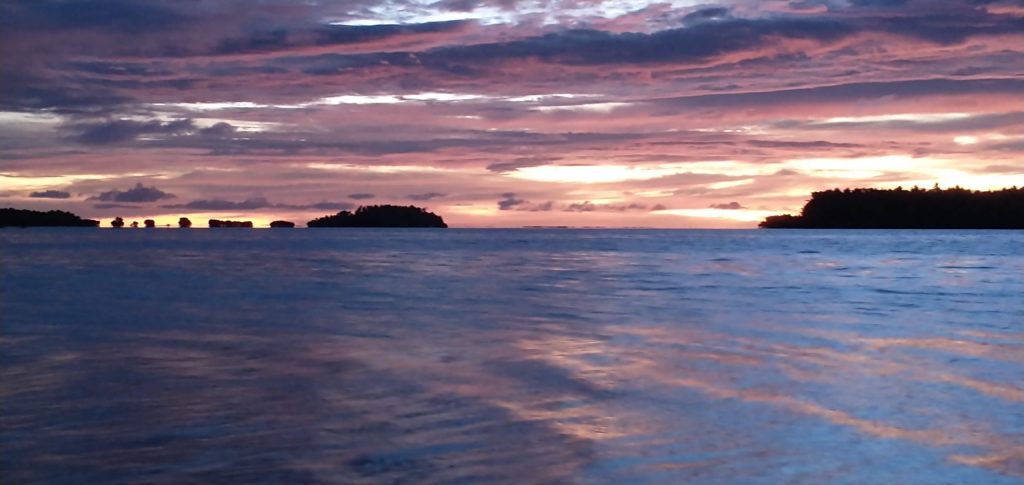
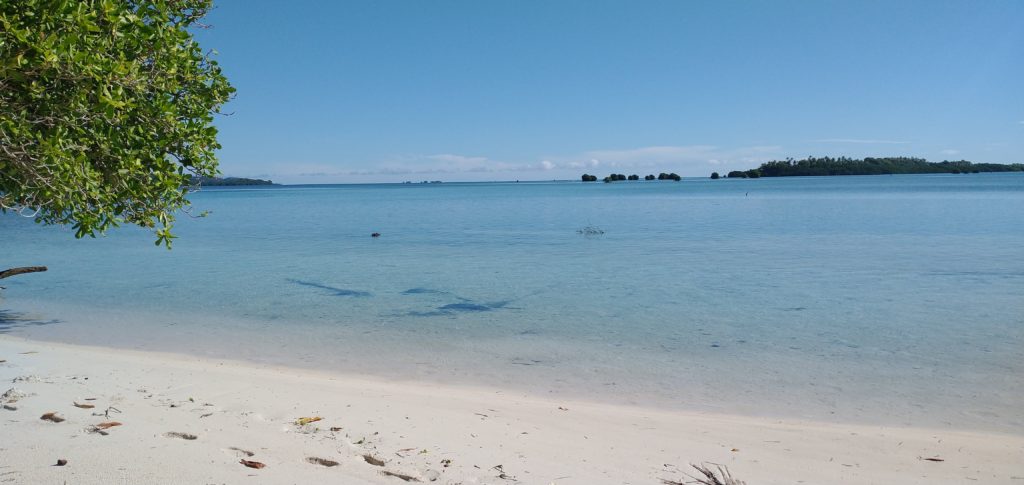
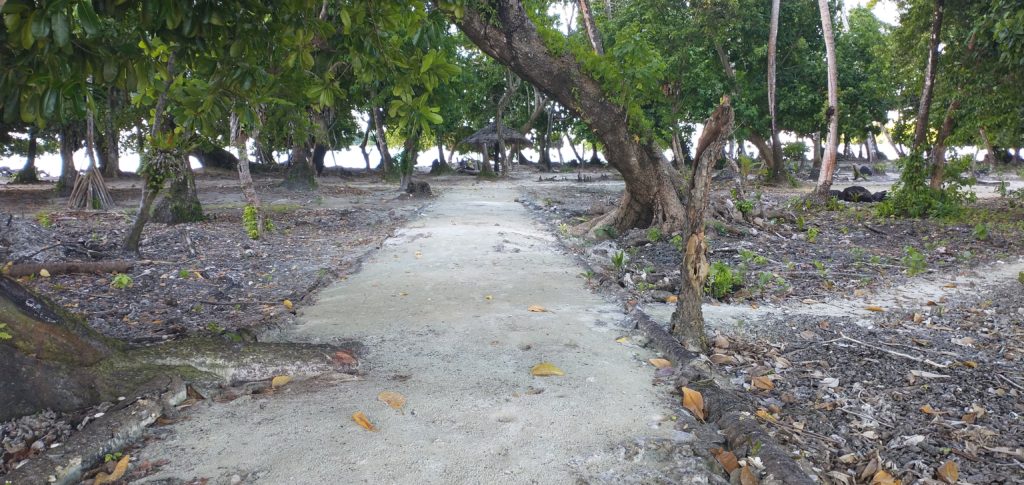
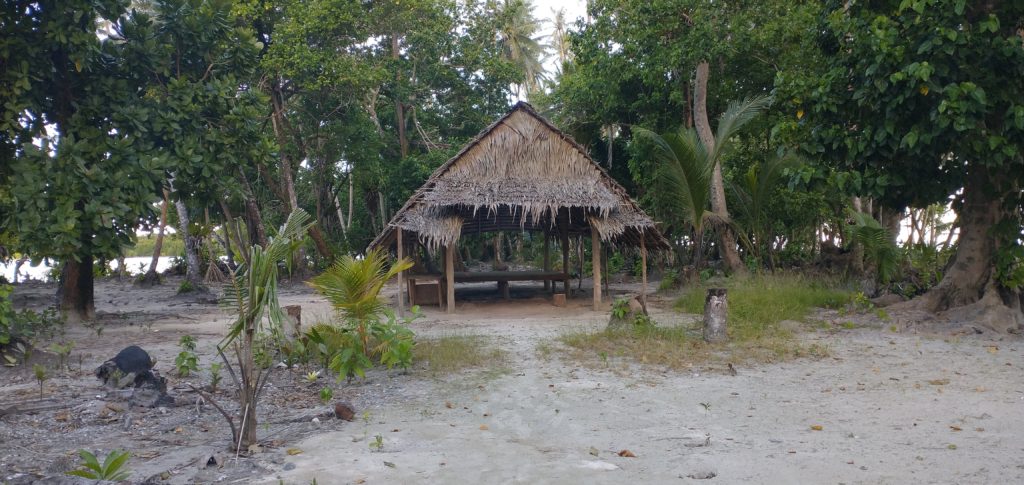
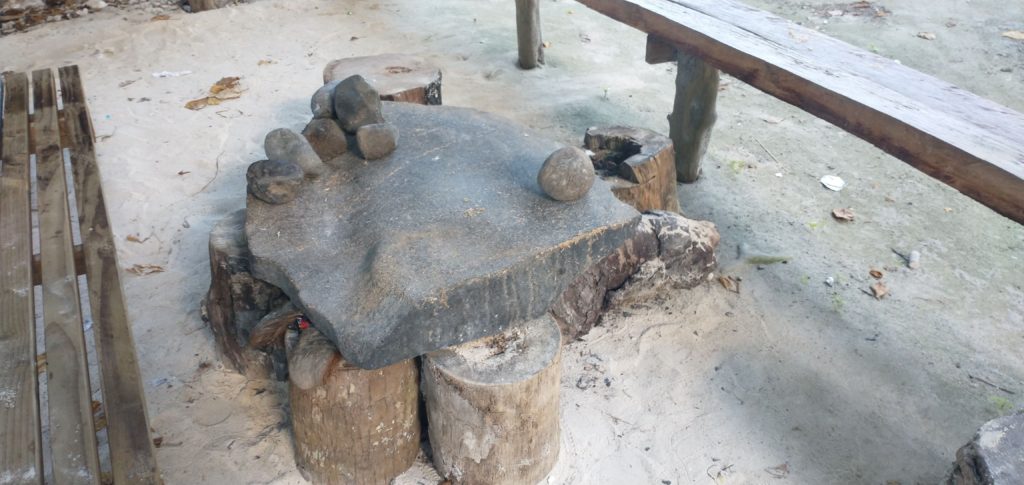
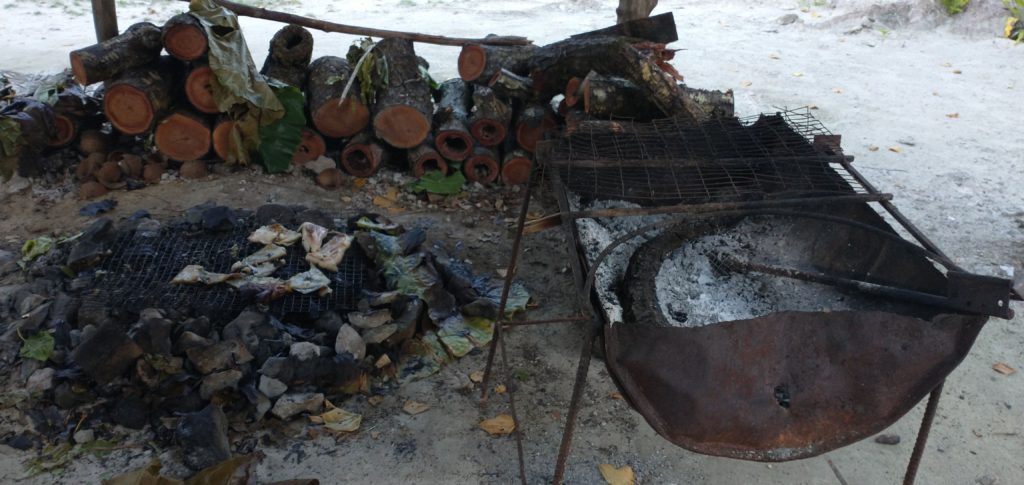
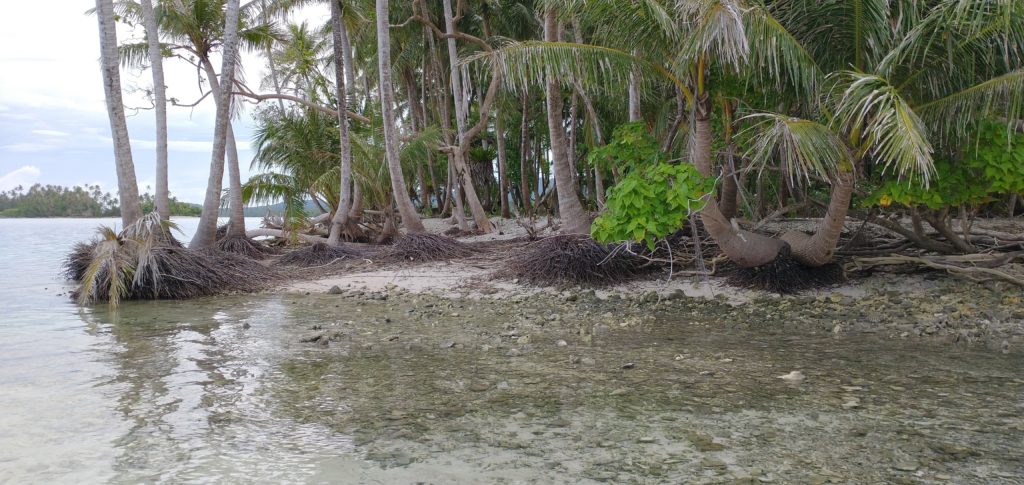
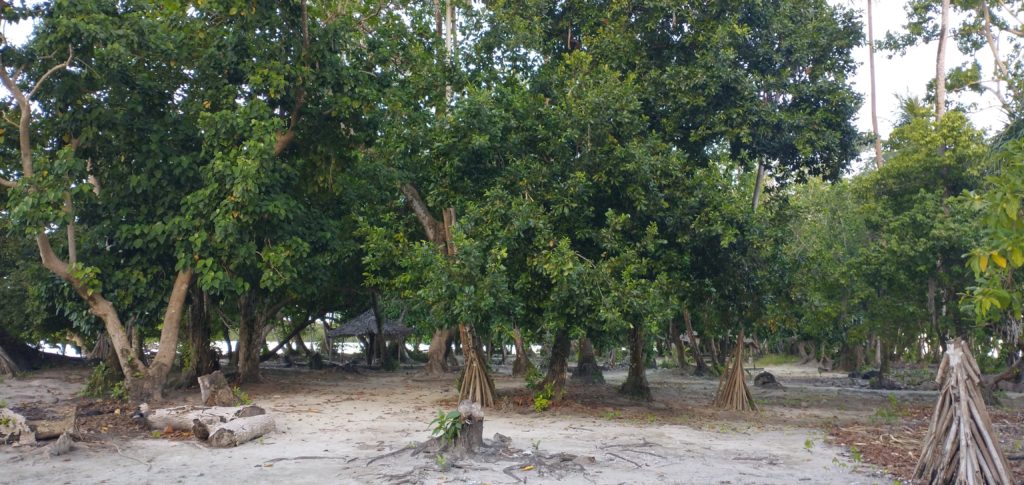
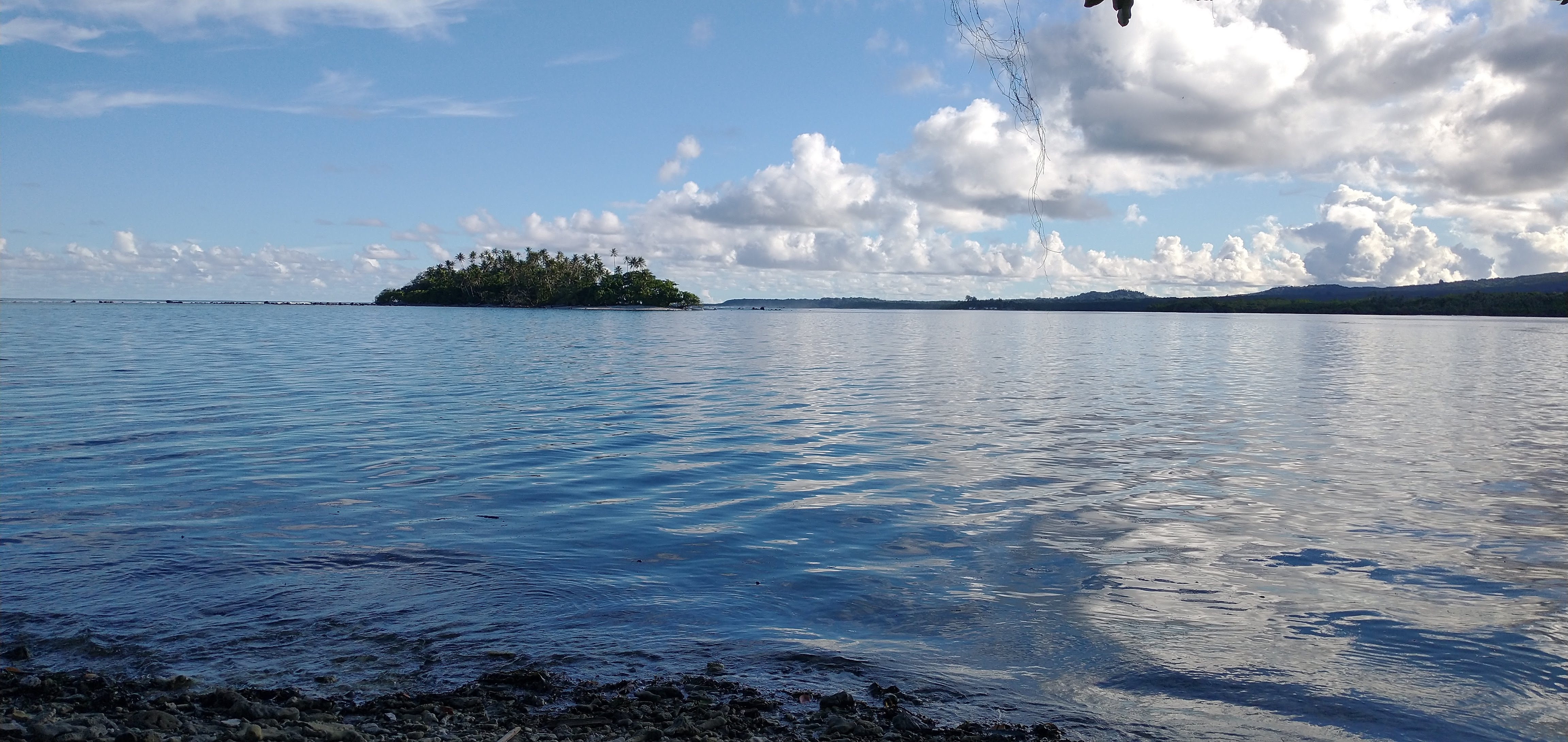
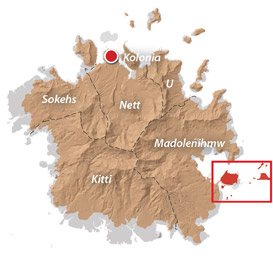
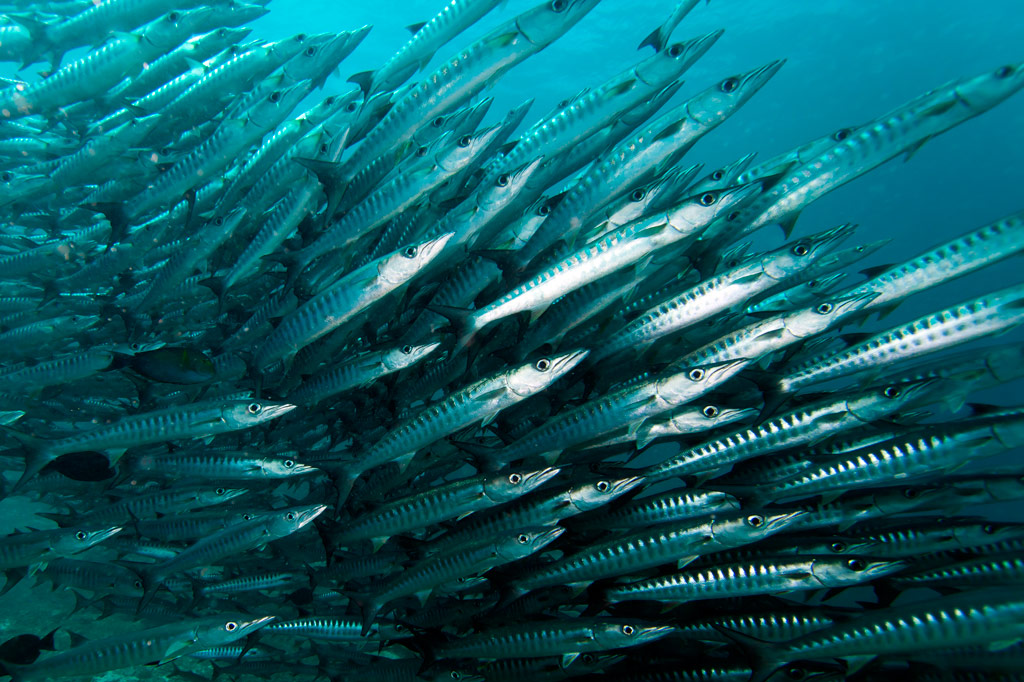
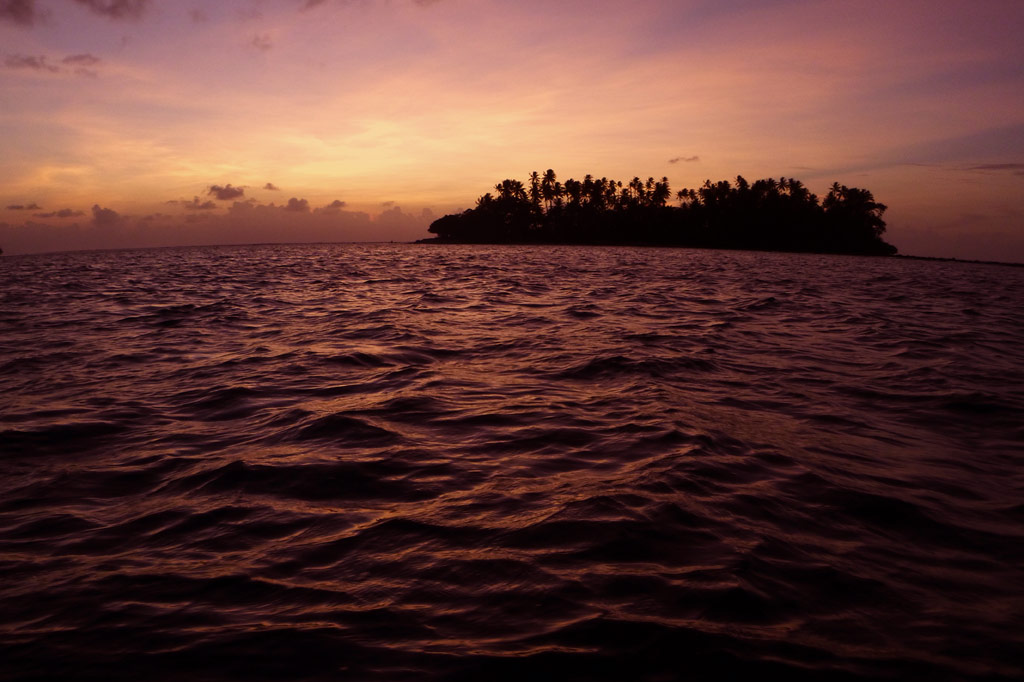

 Further on, stony Salong Point juts north almost to the edge of the channel. Unusual eroded rock formations and a complete lack of mangroves make the place visually unique and worth a look. There’s also a small sea-cave and a portal in the topography that frames conical Takaiuh. Depending on tides and recent rain, the sheltered bay east of the point is sometimes a nice place for a dip, though there isn’t enough coral in the area for snorkeling.
Further on, stony Salong Point juts north almost to the edge of the channel. Unusual eroded rock formations and a complete lack of mangroves make the place visually unique and worth a look. There’s also a small sea-cave and a portal in the topography that frames conical Takaiuh. Depending on tides and recent rain, the sheltered bay east of the point is sometimes a nice place for a dip, though there isn’t enough coral in the area for snorkeling.
